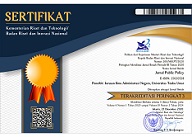Kointegrasi Indeks Saham Sektor Agro Dan Marine Sebagai Sumber Referensi Diversifikasi Internasional Bagi Investor Indonesia
Abstract
Full Text:
PDFReferences
Ali, S., Butt, B.Z. dan Rehman, K. (2011) Comovement Between Emerging and DevelopedStock Markets: An Investigation Through Cointegration Analysis. World Applied
Sciences. 12 (4),395-403.
Assidenou, K E. (2011) Cointegration of Major Stock Market Indices during the 2008 Global
Financial Distress. International Journal of Economics and Finance. 3(2), 212-222.
Bhuvaneshwari, D., & Ramya, K. (2017). Cointegration and causality between stock prices
and exchange rate: Empirical evidence from India. SDMIMD Journal of
Management, 8(1), 39-45.
Clare, A.D., Maras, M dan Thomas, S.H. (1995) The Integration and Efficiency of International Bond Market. Journal of Business Finance. 22(2), pp.313-322.
Engle, R and Granger, C. (1987) Co-integration and Error Correction: Representation,Estimation, and Testing. Econometrica, 55(2), pp. 251-76.
Guidi, F dan Ugur, M. (2014) An analysis of South-Eastern European stock markets: Evidence on cointegration and portfolio diversification benefits. Journal of International Financial Markets, Institutions and Money. 30,119-136.
Hendrawan, R., & Gustyana, T. T. (2011). Kointegrasi Bursa-Bursa Saham di ASIA. Jurnal Keuangan dan Perbankan, 15(2).
Johansen, Søren (1991). "Estimation and Hypothesis Testing of Cointegration Vectors in Gaussian
Khan, T. A. (2011). Cointegration of international stock markets: An investigation of diversification opportunities. Undergraduate Economic Review, 8(1), 7.
Lanouar, C., Najah, A., & Teulon, F. (2015). Socially Responsibility investing and Islamic Fund: New Perspective for Portolio Allocation. Reasearch in International Business
and Finance, 351-361.
Menon, R.N., Subha, M. dan Sagaran, S. (2009) Cointegration of Indian stock markets with other leading stock markets. Studies in Economics and Finance. 26(2), 87-94.
Muhajir, H.M (2008) Analisis Kointegrasi: Keterkaitan Jakarta Islamic Indeks Dengan IHSG dan SBI di Bursa Efek Jakarta. Semarang: Universitas Diponegoro.
Mills, T. C. dan Mills, A. G. (1991) The International Transmission of Bond Market Movements. Bulletin of Economic Research. 43,273—82.
Nishimura, Y., & Men, M. (2010). The paradox of China's international stock market comovement. Journal of Chinese Economic and Foreign Trade Studies.
Subhani, M.I., Hasan, S.A., Mehar, A., Osmen, A. (2011) Are The Major South Asian Equity Market Co-integrated?. International Journal of Humanities and Social Science. 1(12),117-121.
Tabak, B.M. dan Lima, E. J. A. (2003) Causality and Cointegration In Stock Market: TheCase of Latin America. Revista Braviesleira De Economia De Empresas. 3(2). 27-45.
Yang, C., Chen, Y., Niu, L., & Li, Q. (2014). Cointegration analysis and influence rank—A network approach to global stock markets. Physica A: Statistical Mechanics and its Applications, 400, 168-185
DOI: https://doi.org/10.35308/akbis.v7i2.8293
Refbacks
- There are currently no refbacks.





